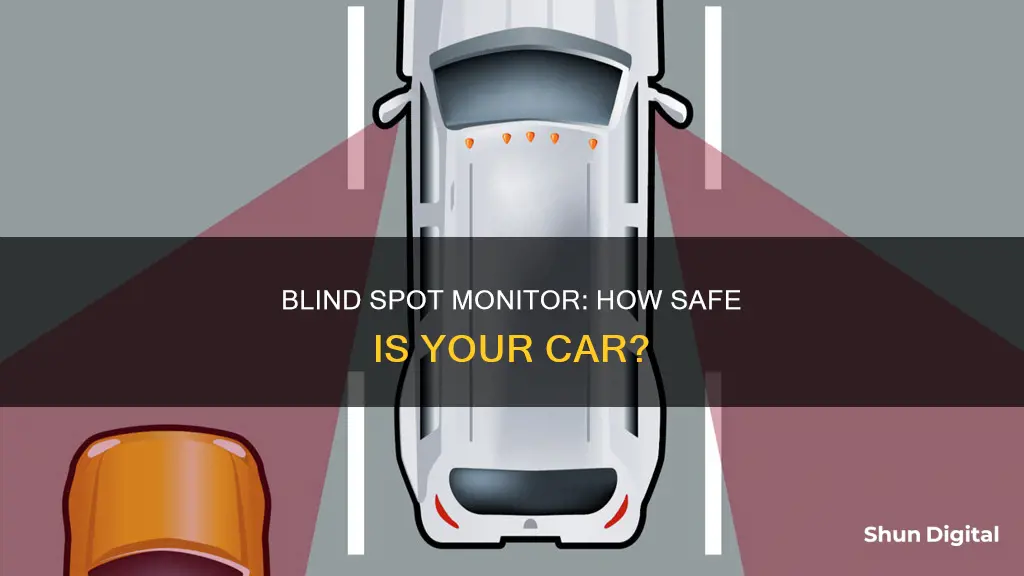
Blind Spot Monitor with Rear Cross-Traffic Alert is a safety feature in vehicles that helps drivers avoid collisions when changing lanes or reversing. It uses sensors, cameras, and radar technology to detect vehicles, people, or objects in the blind spot of the driver, providing both visual and auditory alerts to warn the driver. When reversing, the system can detect cross-traffic approaching from either side and notify the driver through flashing lights, warning sounds, or a combination of both. If the driver does not respond to the alerts, the system may even apply the brakes to prevent a collision.
| Characteristics | Values |
|---|---|
| Purpose | To warn drivers of dangerous lane changes and vehicles in their blind spot |
| Alert Types | Visual and auditory |
| Activation | When vehicle is in reverse gear |
| Activation Speed | Above 15 mph |
| Detection Area | Both sides of the vehicle, extending rearward from the exterior mirrors to 15-30 feet beyond the bumper |
| Alert Locations | Dashboard, rearview mirror, side mirror, sideview mirror |
| Additional Features | Lane-keeping system support, braking intervention |
What You'll Learn
- Rear cross-traffic alert systems use radar or ultrasonic waves to detect vehicles
- Blind spot monitoring systems warn of vehicles in blind spots
- Visual and auditory alerts are used to notify the driver
- The system can engage the brakes to prevent a collision
- The blind spot detection system has a 2-step activation process

Rear cross-traffic alert systems use radar or ultrasonic waves to detect vehicles
Rear cross-traffic alert systems are an important safety feature, designed to help drivers avoid collisions when reversing. They are especially useful when backing out of parking spaces, where it can be difficult to see approaching traffic.
The rear cross-traffic alert system is often paired with a backup camera, which automatically turns on when the vehicle is shifted into reverse. Together, these systems enhance the driver's situational awareness, helping to make backing up safer and reducing the risk of collisions.
While rear cross-traffic alert systems are generally reliable, it's important to note that they are not perfect. They may struggle with detecting small objects, such as motorcycles, bicycles, or pedestrians. Additionally, they may not always work effectively in angled parking situations or when sensors are obstructed. As such, it's crucial for drivers to remain vigilant and use sound judgment, even when equipped with this advanced technology.
Overall, rear cross-traffic alert systems that use radar or ultrasonic waves to detect vehicles are a valuable tool for enhancing driver safety and reducing the likelihood of accidents when reversing.
Spirits Among Us: How to Spot Monitoring Spirits
You may want to see also

Blind spot monitoring systems warn of vehicles in blind spots
Blind spot monitoring systems are designed to warn drivers of vehicles in their blind spots, increasing their awareness of their surroundings and helping them make safer driving decisions. These systems use radar sensors or cameras to detect vehicles, people, or objects that enter the blind spot area on either side of the vehicle. When a vehicle enters the blind spot, the driver is alerted through visual, auditory, or haptic means, such as an indicator light in the side-view or exterior mirror, a warning indicator, or a buzzer. Some systems also provide support through corrective steering intervention, in conjunction with lane-keeping systems.
The detection area of blind spot monitoring systems typically covers both sides of the vehicle, extending rearward from the exterior mirrors to around 15-30 feet beyond the bumper. This area is monitored continuously while driving, alerting the driver if a vehicle is present in the blind spot or if a vehicle is approaching from the rear and about to enter the blind spot.
In addition to blind spot monitoring, some systems also offer rear cross-traffic alert features. This feature is particularly useful when reversing out of a parking space or driveway, as it can detect vehicles approaching from the side. The detection area for rear cross-traffic alerts typically extends around 25 feet to each side of the vehicle, and the system will notify the driver with flashing LED indicators, warning sounds, or visual displays when a vehicle enters this area.
Blind spot monitoring systems with rear cross-traffic alerts are valuable safety features that can help prevent collisions and mitigate the risk of accidents, especially during lane changes, reversing, or when manoeuvring in tight spaces. These systems provide drivers with an extra layer of awareness, ensuring they are alerted to potential hazards that may be in their blind spots.
Finding the Right MSI Monitor Size for You
You may want to see also

Visual and auditory alerts are used to notify the driver
Blind Spot Detection Systems (BSD) and Rear Cross-Traffic Alert (RCTA) are safety features designed to aid drivers in detecting vehicles, people, or objects that may have entered their blind spot area. This is especially useful when reversing out of a parking space or driveway, as it can help to avoid collisions.
When a vehicle enters the driver's blind spot, they are alerted by an indicator light in the side-view or exterior mirror. This light may flash to warn the driver of a potential hazard. In addition to the visual alerts, some systems also emit an audible warning, such as a buzzer or chime, to further attract the driver's attention.
If the driver activates the corresponding turn signal, indicating an intention to change lanes, the LED indicator will begin to flash, and an audible alert will sound to warn of a vehicle in the blind spot. This two-step verification ensures that the driver is made aware of potential hazards and can take appropriate action.
The Rear Cross-Traffic Alert feature uses radar sensors on both sides of the vehicle's rear to detect approaching vehicles when reversing. This is particularly useful when backing out of a parking space, as it provides a greater degree of awareness of the surrounding area. The system will notify the driver with a visual or auditory warning if an approaching vehicle enters the detection area, which typically extends approximately 25 feet to each side of the vehicle.
It is important to note that Rear Cross-Traffic Alert systems have some limitations. They are typically designed for straight parking situations and may not work as effectively in angled spots. Additionally, the sensors may not detect small objects such as motorcycles, bicycles, or pedestrians, and may also fail to detect vehicles approaching directly from behind.
The Ultimate Guide to VESA Mounts for ASUS MX279H Monitors
You may want to see also

The system can engage the brakes to prevent a collision
Blind-spot monitoring (BSM) is a safety feature that uses sensors, cameras, radar, and/or ultrasonic sensors to detect vehicles, objects, or pedestrians in a driver's blind spot. This is particularly useful for changing lanes or merging, as it can help to prevent collisions. The system will alert the driver with a warning, which can be visual, audible, or tactile, such as a shaking of the steering wheel.
Some vehicles are also equipped with a Blind Spot Assist (BSA) function, which can take more active measures to prevent a collision. If a driver indicates to merge into a lane that is occupied by another vehicle in their blind spot, the BSA system may engage the brakes on one or more wheels to nudge the driver back towards the centre of their own lane. This can be particularly useful when towing a trailer, as the system can detect cars next to the trailer and help to avoid sideswiping them.
Rear Cross-Traffic Alert (RCTA) is another feature that is often bundled with blind-spot monitoring. RCTA is helpful when reversing out of a parking space, as it can detect vehicles, objects, or pedestrians crossing behind the car. If a potential collision is detected, the system will issue an audible warning, and more advanced systems will automatically apply the brakes.
The Volkswagen Rear Traffic Alert system is an example of a safety feature that combines aspects of BSM and RCTA. It can detect cross-traffic and obstacles behind the vehicle when reversing and will alert the driver with a chime and a warning indicator. If the driver does not respond to the warnings and a potential collision is detected, the system will engage the brakes to help avoid a collision.
Cleaning LCD Screens and Monitors: Safe Solutions and Techniques
You may want to see also

The blind spot detection system has a 2-step activation process
Blind spots have always been a major safety hazard for drivers. These are areas around a car that cannot be seen using standard rearview mirrors, and they pose a high risk of accidents when turning or changing lanes. A blind spot detection system is a safety feature that warns the driver of potential hazards in their blind spots.
The system uses radar or microwave sensor technology to monitor the areas around the vehicle. When another vehicle enters the detection area, the driver will be alerted through visual and/or audio signals. Visual alerts are often placed on the vehicle's A-pillar, while audio alerts are connected to the vehicle's turn signal circuit.
The blind spot detection system is a valuable addition to any vehicle, improving overall situational awareness and helping to prevent collisions.
Luma's Monitoring Features: Keeping Tabs on Device Usage
You may want to see also
Frequently asked questions
A blind spot monitor is a system that warns you of dangerous lane changes. It uses an LED display in the exterior mirror to show you if there is a vehicle in your blind spot. When you indicate to change lanes, it alerts you by flashing conspicuously.
Rear cross-traffic alert is a system that helps you back out of spaces where you may not see approaching traffic, such as in parking lots. It monitors two areas behind you for vehicles approaching from the right or left.
Rear cross-traffic alert is active once the vehicle is shifted into reverse. When backing up, you will receive a visual or auditory warning if an approaching vehicle enters the rear cross-traffic alert detection areas. The visual warning may appear on the dashboard, rearview mirror, or side mirror.
When you shift into reverse, both the rearview camera and the rear cross-traffic alert systems will automatically turn on. The rear cross-traffic alert system will alert you when other vehicles are detected near or in your backing path.
Rear cross-traffic alert is not designed to detect small motorcycles, bicycles, or pedestrians. It may also fail to detect vehicles that are approaching from directly behind you or moving away from your vehicle. Additionally, most rear cross-traffic alert systems work best in straight parking situations and may not work as well in angled-parking situations.







